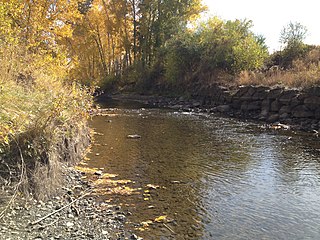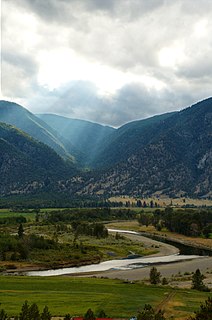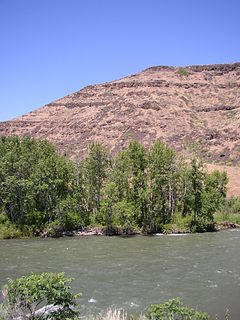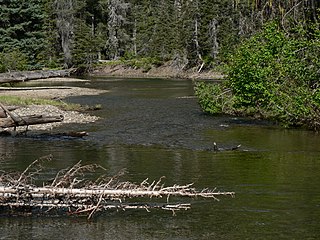| Skookumchuck River | |
Skookumchuck River in Bucoda, WA | |
| Country | United States |
|---|---|
| State | Washington |
| County | Lewis, Thurston |
| Source | |
| - coordinates | 46°42′28″N122°26′41″W / 46.70778°N 122.44472°W [1] |
| Mouth | |
| - coordinates | 46°43′10″N122°58′55″W / 46.71944°N 122.98194°W Coordinates: 46°43′10″N122°58′55″W / 46.71944°N 122.98194°W [1] |
| Length | 45 mi (72 km) [2] |
| Basin | 181 sq mi (469 km2) [3] |
| Discharge | for river mile 6.4 near Bucoda |
| - average | 1,972 cu ft/s (55.8 m3/s) [4] |
| - max | 8,560 cu ft/s (242.4 m3/s) |
| - min | 40 cu ft/s (1.1 m3/s) |
The Skookumchuck River is a 45-mile (72 km) long [2] river located in southwest Washington, United States. It is a tributary of the Chehalis River and thence to the Pacific Ocean. The Skookumchuck Dam was built in 1970, creating the Skookumchuck Reservoir. The dam provides water supply for the 1400-megawatt Centralia Steam Electric Plant and supplements flows for fish resources. The river begins with several tributaries in the Snoqualmie National Forest in the foothills of the Cascade Mountains, and flows west past the town of Bucoda, Washington to its confluence with the Chehalis River near Centralia, Washington.

Washington, officially the State of Washington, is a state in the Pacific Northwest region of the United States. Named for George Washington, the first president of the United States, the state was made out of the western part of the Washington Territory, which was ceded by Britain in 1846 in accordance with the Oregon Treaty in the settlement of the Oregon boundary dispute. It was admitted to the Union as the 42nd state in 1889. Olympia is the state capital; the state's largest city is Seattle. Washington is sometimes referred to as Washington State, to distinguish it from Washington, D.C., the capital of the United States, which is often shortened to Washington.

The Pacific Ocean is the largest and deepest of Earth's oceanic divisions. It extends from the Arctic Ocean in the north to the Southern Ocean in the south and is bounded by Asia and Australia in the west and the Americas in the east.

Snoqualmie National Forest is a United States National Forest in the State of Washington. It was established on 1 July 1908, when an area of 961,120 acres was split from the existing Washington National Forest. Its size was increased on 13 October 1933, when a part of Rainier National Forest was added. In 1974 Snoqualmie was administratively combined with Mount Baker National Forest to make Mount Baker-Snoqualmie National Forest. In descending order of land area, Snoqualmie National Forest lies in parts of King, Snohomish, Pierce, and Kittitas counties. There are local ranger district offices in North Bend and Skykomish. Its main base is in Everett, Washington. As of 30 September 2007, it had an area of 1,258,167 acres, representing about 49 percent of the combined forest's total acreage.
Contents
The name Skookumchuck derives from Chinook Jargon: in this context, "rapids". The word skookum means "strong", and chuck means "water". [5]
Skookumchuck is a Chinook Jargon term that is in common use in British Columbia English and occurs in Pacific Northwest English. Skookum means "strong" or "powerful", and "chuck" means water, so skookumchuck means "rapids" or "whitewater", or fresh, healthy water. It can mean any rapids, but in coastal usage refers to the powerful tidal rapids at the mouths of most of the major coastal inlets.
Chinook Jargon is a nearly extinct American indigenous language originating as a pidgin trade language in the Pacific Northwest, and spreading during the 19th century from the lower Columbia River, first to other areas in modern Oregon and Washington, then British Columbia and as far as Alaska and Yukon Territory, sometimes taking on characteristics of a creole language. It is partly descended from the Chinook language, upon which much of its vocabulary is based.

















